Actually, there is a lot of nature in almost all of Dempsey’s paintings but a few, like the gull on the beach and the bluebird on thepost and the absolutely beautiful mountain stream “Wilson’s Creek” just call out to be classified as a ‘Nature prints’.
You’ll enjoy these scenes that smell of salt air and wildflowers and the sounds of flowing water and birds.
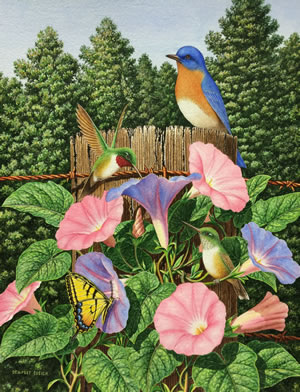
Image size: 15 1/2 x 11 3/4
"September Morning"
A joy of September is the arrival of the morning glory in gardens and cornfields just in time for harvest. The morning glory with its twining vines and bell shaped flowers that last only for a day, adds a wonderful touch of color to the landscape as the fall season nears.
The rendering is a happy depiction of hummingbirds, a bluebird and a butterfly enjoying the freshness of an early September morning. May this painting alert you to the abundance of morning glories on our surrounding countryside. Distinguish the male hummer and then look closely for the hidden hummer.
"Since our last posting, our fine art printer and long time friend, Tom Hall passed away after a sudden two month illness and we are still reeling from that loss. Due to that and my upcoming retirement, I am sad to report that there will be no fall print release. As I prepare for our last Christmas season in the shop, I have released a small edition print that features my favorite subject matter. It will be sold framed only, on a first come basis."
Dempsey
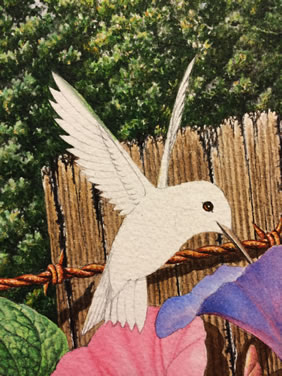
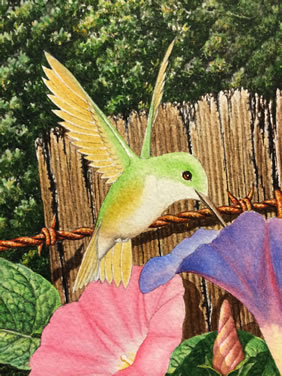
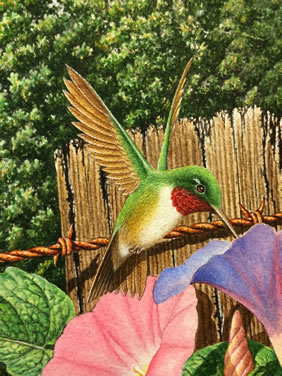
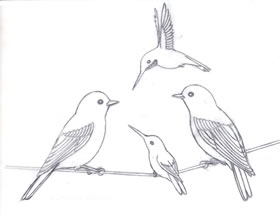
Rumor has it that thousands of hummingbirds failed to make migration but rather chose to meet on local power lines with area bluebirds to discuss the retirement of Hummingbird Artist and Bluebird Lover Dempsey Essick.
Happy Retirement, Dempsey!
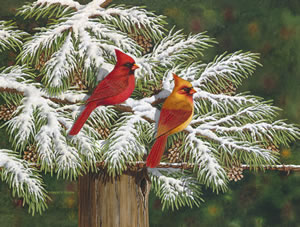
Image sizes: 11 3/4 x 15 1/2 • Giclee Print: $120
15 x 20 • Oversize Print: $150
"Hangin' Out in the Pines"
Yes, hummingbirds are migrating south now but cardinals, on the other hand, are flocking to the Dempsey Essick Gallery in Downtown Welcome for the release of his new print, “Hangin’ Out in the Pines”.
“I love cardinals,” Dempsey shared. “They don’t migrate, they mate for life, and they become very social at the feeding station. Many times it’s the cardinals gathered outside my studio window that keep me company during my long winter painting days. I have noted no less than 9 cardinals outside my studio window that came and stayed for days at the time. They acknowledge me when I come to replenish their food supply and they are not territorial meaning they love the company of other cardinals.”
“One of the great things about cardinals is that their colors brighten up any dreary day. They stand out dramatically against the earth tones of winter. This pair of cardinals is hanging out on a pine branch, just after a heavy snow, awaiting to be fed. The pines provide a haven for the cardinals as well a place to roost each evening. This painting causes me to feel at ease because of the peace and quiet of it. I hope you will experience the same.”
This hidden hummer included here is very subtle but easy to see because of its size. Also, how many pine cones do you count in the painting?
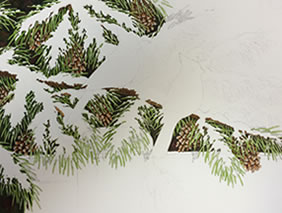

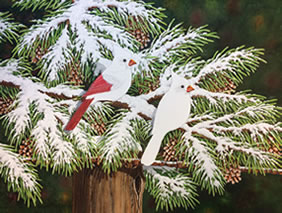
Shelley Shares
“Our days are long when Dempsey is working in the studio,” shares wife, Shelley Essick.
“When Dempsey is focused on a painting, he works from morning into the night; sometimes 18 hours at a time. He may go several days and not speak a word. I have learned that this is a good thing and to leave him alone. When he is truly focused his mind is not wandering and he gets more accomplished."

The early days

Dempsey and Shelley add the 1000th
piece to an intricate hummingbird puzzle
"We don’t go out to eat during these time and we don’t have a social life. Background noise is usually westerns. I go to the library and check out all the old cowboy movies. He knows them all by heart because he plays them over and over and over again."
"Painting is his priority and he sticks with it. The end result of all this effort are these beautiful, breath taking works of art where the grass is painted literally blade by blade or each leaf is made up of three shades of green."
"You have heard it said about an artist’s suffering when he creates and I am here to tell you that it is true because I have seen it many times over. I am so honored to be married to such a talented man- a man that I met in high school art class.”
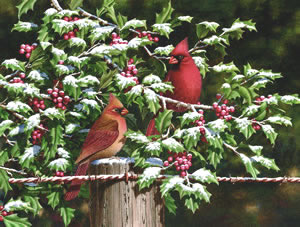

Hangin' Out in the Holly is a sister piece to "Hangin' out in the Pines" together make the perfect composition.

Available framed only $35
"Looking for a Mate"
I want to dedicate this painting to our daddy bluebird who has shown to be an exemplary father.
We had the same pair of blues for years (when you feed them daily they get to know you and you get to know them personally) and we were saddened to come home and find mama bird dead in the road. It was during nesting time and the babies had hatched.
All alone, that daddy bird worked continuously to keep those four babies fed until they finally fledged. It was only after the kids left home and he taught them to feed did he go looking for a wife.
The first female he brought did not like our box and it was the second female who approved, stayed, and continued the family.
We were privy to this and were honored to be included in the restructuring of the family.
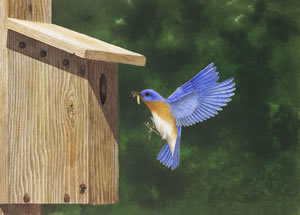
$110 + up
"Cleared for Landing"
"The relationship between the father bluebird and his family is special. As a bluebird lover, nature artist, and past president of the NC Bluebird Society, I have studied at great length how the male bluebird cares for his family. While the female is on the nest, Papa Blue is constantly flying back and forth with food for his mate. I am always amazed to watch him fly to the box at breakneck speed, land softly on both feet, enter the box half way, feed his mate, and never disturb the nest."
"'Cleared for Landing' portrays a male bluebird on a final approach to a landing with a meal worm in his mouth. I hope this painting will encourage you to put up a bluebird box so that you also can have the wonderful experience of watching the blues raise their family right in your own back yard."
Look for the hidden hummingbird in the knot on the side of the bird box.

$80 + up
"Box Watch"
Though the house is old and the paint is fading, the mother bluebird can still create a loving home for her young. The dogwood tree is in bloom, which means it is spring and new life is about to enrich the neighborhood.
This watercolor gives a bird’s eye view of the simple life of the bluebird. The artist, Dempsey Essick, loves bluebirds. He is the past President of the NC Bluebird Society; he feeds bluebirds daily and speaks publically on the plight of the Eastern Bluebird. “Box Watch” is the most recent addition to Dempsey’s collection of bluebird related art.
The rebus image of a hummingbird is hidden in the chipped paint at the 1:00 position from the bird box hole.
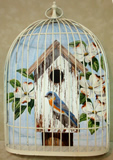

$150
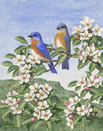
2010 Edition: 999
Image size: 10 x 7 7/8
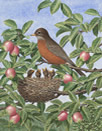
2010 Edition: 999
Image size: 10 x 7 7/8

2010 Edition: 999
Image size: 10 x 7 7/8
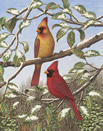
2010 Edition: 999
Image size: 10 x 7 7/8
"Grandfather's Four Seasons"
“This is surely the most unusual project I’ve ever done, “ commented Welcome Artist Dempsey Essick, referring to his fall print entitled ‘Grandfather’s Four Seasons’.
Dempsey’s latest release presents a unique concept in the world of art and of birding as he has captured the single limb of an apple tree as it extends through the four seasons.
‘Spring’ with its bluebirds and apple blossoms give way to a ‘Summer’ robin and her chicks amidst the young apples. ‘Fall’ brings Black Capped Chickadees frolicking among the apples that are ready for harvest while a pair of cardinals on a snowy branch represent ‘Winter.’
Since each of the four scenes occupies space along the same tree limb, the always innovative Dempsey plans to offer a choice of either a single print which combines each of the four seasons in a beautiful panorama or as two pairs of deckled prints which present an unusual and striking view as well.
"Spring" and "Summer" are a pair as well as "Fall" and "Winter". The issue price on each pair is $120 and $150 for the single large print.
The view of Grandfather Mountain is near Foscoe, NC where the artist enjoys fly fishing and camping.
As it is Dempsey’s custom to include the rebus image of a hummingbird in his paintings, please note there is a hidden hummer in each season.
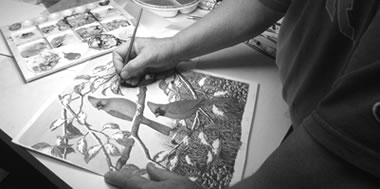
Dempsey Shares
“I found the idea of painting four different birds in four different seasons intriguing and I had thought about it for a long time. I’d also wanted to do something with Grandfather’s Mountain so when I found this view of an orchard near Foscoe, NC it was the perfect setting for combining the two ideas.”
“As you may well know the bluebird is my favorite bird. Bluebirds don’t migrate, they stay with you year round, and they are loyal friends but these other birds are close to my heart as well. This is the first time I’ve included a robin in a print and it was a joy to paint her chicks. The chickadees are among my favorite songbirds as I love to watch them as they flick about my feeding station in late evening. And as for cardinals... during the long winter months when I’m painting, they have kept me company outside my studio window.”
“ When you look at this print may you be reminded that you can bird watch year round. Birding never goes out of season. Regardless of when or where you are, the birds are there.”
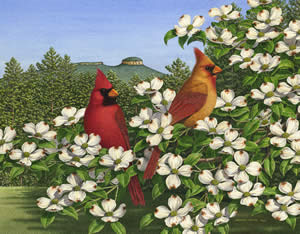
$120
"Carolina Calling"
Dempsey Essick is not just a bird lover; he is a bird fanatic. In addition to his beautiful depictions of birds in many of his paintings he is a past president of the N.C. Bluebird Society and speaks publicly about the plight of the Eastern Bluebird. He started a bird watching club in his own community and has come to be known as the Hummingbird Artist Outside his studio window he keeps a table full of tasty treats (everything from crushed egg shells to softened raisins to cornbread) for the birds so that, when he is working on a painting he can be constantly entertained by every type of songbird native to the Piedmont Region of North Carolina. Just recently, he was visited by an itinerant peacock who had undoubtedly heard about the free smorgasbord at the feeding station in the Essick back yard. The peacock hung around for a few days then departed for parts unknown.
For "Carolina Calling," Dempsey has portrayed a pair of cardinals on the limb of a dogwood which is in full bloom. It is the nesting season and the cardinals, who mate for life, are looking for the ideal spot to raise their family. The cardinals and the dogwood are official symbols of North Carolina.
Pilot Mountain, in the background, is not an "official" symbol but it is one of the best known landmarks in the state. Centuries ago, the Sauratown Mountains in Surry County stood tall and imposing but, over the years the mountains have eroded away leaving the spectacular knob of quartzite that we now call "Pilot Mountain." The mountain served as a guidepost for the earliest natives and for the later settlers as they migrated south to settle Piedmont North Carolina.
Pilot Mountain is the perfect background for Dempsey's painting; it establishes the locale, adds interest to the overall picture and brings a touch of natural beauty into the life of every viewer.
Dempsey's Shares
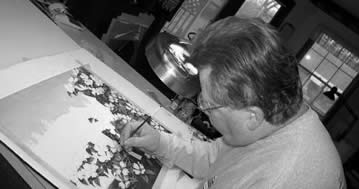
Cardinals have been good company to me. They stay year round and visit my feeding station daily. I take breaks from my painting to fill all the feeders with a variety of food. I am faithful to the birds and they are faithful to me.
As for the dogwoods, they are my favorite flowers. One joy of spring is watching the dogwood tree outside my studio window. Cardinals are abundant and their colors are striking against the contrast of the blooms.
I have always wanted to paint a pair of cardinals especially after I held and studied a juvenile cardinal that became trapped in our carport. We made several photos and the experienced only increased my love of birding.
I searched for a place to do my cardinal and dogwood painting but around home was not a good location. I sought out a dogwood tree in Surry County just south of Pilot Mountain for this view. I made my photographs just off of Caudel Road on an old tractor path, about 5 miles from the mountain.
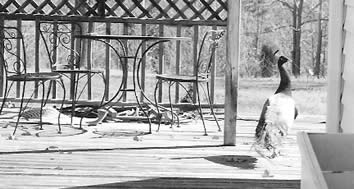
This is a simple yet very detailed painting that speaks of spring in North Carolina. Red, in watercolor, requires multiple layers to create the proper effect of the subject matter.
It is probably the most difficult color to work with and I had to take extra effort in painting the birds so their softness and feathery look was maintained.
I stood for most of this project (it made my back feel better) propped over my drawing board for long hours painting multiple layers in each petal of the dogwood. Each petal has no less than 3 layers of paint of it. Since every dogwood bloom is unique, the challenge for me was to make sure that each bloom I painted was different in shape and size.
A birding surprise during this painting event occurred in late March when I looked out the window at the feeding station and there stood a beautiful peacock, eating with all the other birds. I gasped, ran for my camera, and got a quick shot before it disappeared. Now I have added yet another bird to the list of those who have dined at my table.
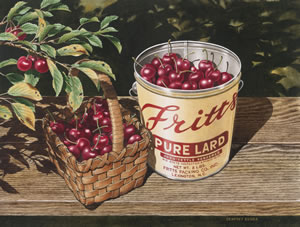
2007 Edition: 999 • Image size: 12 1/2 x 16
"Cherry Pickin' Good I & II"
A Pair of Prints
Dempsey and Shelley Essick have this old, black cherry pitter that has been in the family so long it is like a fixture or an old friend. Every summer they get it out and clean it up for the annual cherry harvest. This summer will be no exception.
When the cherries turn red it is like a signal flag to every bird in the neighborhood that it is "Cherry Pickin'" time. The humans have to race with the birds to get at least a fair share of the enticing fruit.
Anything easy to hold is a suitable container for picking. In his painting, "Cherry Pickin' Good," Dempsey has filled a small, hand woven, basket and an old "Fritts Packing Company" lard can. They'll empty these into a large bucket then fill them up again. The whole time the birds will be circling, squawking and waiting their chance at the tasty red berries.
In his painting, Dempsey has captured the essence of summer at that point where mother earth is beginning to yield her bounty. A few of the leaves are beginning to change color and, soon, a light sweater might feel good in the evenings. There can be no better way to end one of those cool days than to sit down to a slice of cherry pie, still warm from the oven, with a bit of rich cream to pour over it.
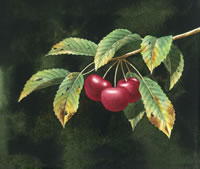
2007 Edition: 999 • Image size: 6 1/2 x 7 1/2
No artist working today is any more skilled at reproducing, exactly, small segments of our every day lives in such a way that each of us can see the larger picture in our minds. Never mind that each viewer may see a slightly different picture, depending on his or her past experience, the picture is still true. Great art is not just a delight for the eye but touches the heart, the soul, and the mind.
$120 for the pair
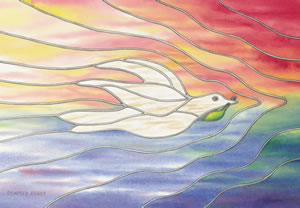
$25
"Back to the Ark"
I was delighted when Crisis Control Ministry asked me to do a painting for their new Honor and Memorial Card.
I wanted an image of a dove that was different from what they had used and I liked the idea of the stained glass appearance.
The painting depicts Noah's dove with an olive leaf in its mouth as it flies through the rainbow returning to the ark, bringing the light of God's promise into a dark world.
About Crisis Control Ministry
Help for Today. Hope for Tomorrow.
Crisis Control Ministry was established in 1973 by six downtown Winston-Salem, NC churches to create a comprehensive system of response to the emergency needs of people in Forsyth County. Since that time, Crisis Control Ministry has grown to over 300 supporting congregations, over 500 volunteers, and a budget of over $2 million.
Through the years, the Ministry has helped birth the Samaritan Soup Kitchen, Habitat for Humanity and the Second Harvest Food Bank of Northwest North Carolina. In 1987, the Ministry opened the first state-licensed free pharmacy in North Carolina.
Through the support of grants and foundations, churches, individuals, business partners and special projects such as the Dempsey Essick Honor & Memorial card and its signed, limited edition prints, the ministry is able to continue its mission: to assist people in crisis to meet essential life needs and become self-sufficient.
The Crisis Control Ministry is located at 200 E Tenth Street in Winston Salem, NC.
For more information you may visit their website at www.crisiscontrol.org or reach them by phone at 336-724-7875.

$50
"Fishing Buddy"
In addition to being an avid bird watcher, Dempsey Essick is just as enthusiastic about fishing. He combines the best of both worlds when he is down on the seashore surf fishing. After he casts his weighted hook out over the breakers and settles down to await a strike he watches the pelicans skimming the wave tops and the busy sandpipers as they chase the receding waves looking for the telltale air bubble that marks the location of a tender mollusk.
It is fascinating to watch as the small brown birds run in front of an incoming wave then stop and chase the same wave as it returns to the sea. There will be dozens of them, unafraid of the fisherman or the thundering waves, constantly running, stopping only to probe the sand with their long beaks.
It was during one of Dempsey's surf fishing trips that he decided to paint his little fishing buddy who was racing to and fro in the sand He did a careful study of the sandpiper and the sand and then proceeded to created a painting so real that the viewer has to look hard to be sure that there is not real sand scattered on the image.
As is his custom, Dempsey has included the rebus type image of a hummingbird in the painting.
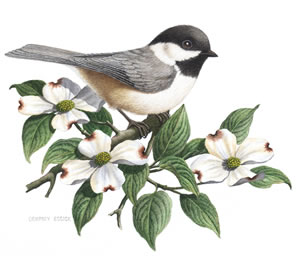
2006 Edition: 200 • Image size: 10 x 10
Hidden Hummingbird: Yes
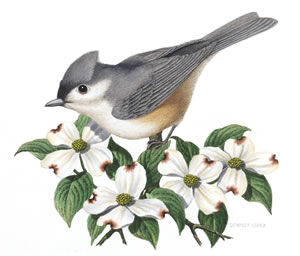
2006 Edition: 200 • Image size: 10 x 10
Hidden Hummingbird: Yes
"Studio Friends: A Pair of Prints"
"Busy" and "Energetic" are the two words most often used in describing the "Carolina Chickadee." All you need is a window feeder with a handful of sunflower seeds and you can be guaranteed a visit every day. It is fascinating to watch as the small gray and black birds pick up a seed, fly to a nearby limb, place the seed between their feet and peck it open. Then they return for another, and another, and another...
Colored an almost textured pearl gray and white, the Tufted Titmouse is a small bird with a big voice. If one partakes of the sunflower seeds in your window feeder you can hear their "CLEAR, CLEAR, CLEAR" call throughout your house and yard. They are cousins of the Carolina Chickadee. Where you see one you'll usually see the other. They are like Mother Nature's decoration for your yard.
Titled so because of the company they provide Dempsey during his long hours of painting, "Studio Friends" each contain a hidden hummingbird image.
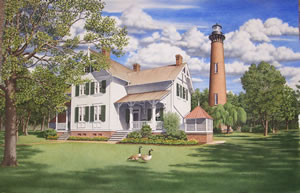
$120
"Currituck Afternoon"
Erupting through the sand of North Carolina's outer banks like giant smokestacks, a chain of picturesque lighthouses guide passing ships around the notorious "Graveyard of the Atlantic." Each of the lights can be identified, at night, by its distinctive flashing signal. Four of the lights, built on the Cape Lookout plan, look enough alike in daylight that each light has a distinctive "daymark." Cape Lookout is painted in black and white diamonds; Cape Hatteras has a black and white spiral; Bodie Island has black and white bands; and one light, the one at Currituck Beach, near the village of Corolla, was left unpainted.
The oil wicks were first lighted in the Currituck Beach Light on December 1, 1875. Burning whale oil at first and later kerosene, the keepers carried the oil up 214 spiral steps to fuel the light. The rotating mechanism, which was powered by weights, much like a grandfather clock, had to be rewound every two and a half hours throughout the long and frequently stormy, night. The first order Fresnel lens, which was installed when the tower was built, is still in use today, sending a warning flash of light every twenty seconds across nineteen nautical miles of treacherous ocean.
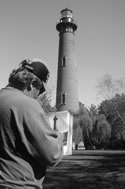
Dempsey sketching
In his painting of the Currituck Beach Light Station, Dempsey Essick had focused on the three-story, Double Keepers Quarters. Prefabricated and hauled to the site, the house is the lone survivor of three US Lighthouse Service, Grand Duplex style houses using the "Stick Style" architecture that has since been copied by hundreds of beach dwellings and is now known as "Outer Banks Style." Dempsey's meticulous attention to detail includes the interconnected roof gutters designed to route rainwater to the covered and ventilated underground cisterns at each side of the house. The cisterns were the only source of fresh water for the two families who shared the three-story dwelling.
Viewers who are unaccustomed to the rich detail of a Dempsey Essick painting will be delighted as they delve into the picture and become aware of the small touches like the tree leaves and flower petals, and the bricks, and the wood grain. Those who have done some painting themselves will be astonished at the technique, especially the realistic cloud formations, thought by many to be impossible using watercolor. Dempsey has experimented for years to perfect his own technique to realistically reproduce cloud formations in his paintings. The beautiful bank of cumulus clouds behind Currituck's brick tower is a testament to his persistence and his devotion to his craft.

Dempsey painting
In the end, the viewer comes away with a sense of what it was like in the early days, before there was even a road to Currituck. In those days the Keepers and their families came by boat, by horse and wagon, and, later, in cars with half the air let out of the tires for traction in the sand. They were the people who worked in the face of hurricanes to keep the sea-lanes safe. They cultivated gardens and planted flowers and made a home in the wilderness. And always - always towering in the background, there was The Lighthouse, dominating and insistent like a beautiful but dependent child, always in the comer of the eye, always demanding the full measure of the Keepers time and energy.
In "The Currituck Keepers Quarters," Dempsey Essick has captured more than just a beautiful and historic scene. He has also captured a glimpse of the spirit of independence and self-reliance that has made our country great.
As is the artist's custom, he has included the rebus type hidden image of a hummingbird in this painting. Actually, in this piece, there are two hidden hummingbirds. Good Luck...
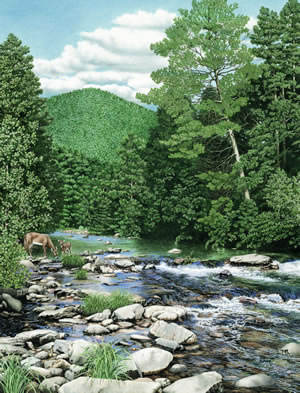
$120
"Wilson Creek"
Living on the Piedmont plateau of North Carolina, Dempsey Essick has always felt fortunate to be in such close proximity to the white sand beaches and the islands of the Outer Banks with their great fishing and picturesque lighthouses. At the same time, it is only a short drive west to be in some of the most beautiful mountains in the world, the beautiful Blue Ridge Mountains of the Appalachian Range.
Some of Dempsey's fondest memories are of family picnics along the Blue Ridge Parkway and splashing in the tumbling waters of a cool stream. The play of sunlight on the still pools and reflections from the smooth rocks and verdant foliage, even when he was very young, appealed to his budding artistic sense. In those early days, he was awed by the absolute silence of the deep forest, the lush green of trees that were there when Columbus discovered America. He is still awed by those same things today. He spends much of his leisure time hiking, fishing and camping in the mountains.
One of Dempsey's favorite spots for camping is the Mortimer Recreation Area, in the Pisgah National Forest, just south of the Edgemont community. He spent two days on the hiking trails, looking for a scene that would speak to him and tell him that here was the site for his next painting. He had left the dirt road and was wading upstream in Wilson Creek where there was no trail when he came around a bend in the stream and the bells and whistles went off in his head. There before him was a view that almost took his breath away.
In the foreground, right at his feet, was a small rapid with the crystal clear water tumbling over rocks smoothed by centuries of being immersed. Just beyond was a clear pool that seemed to invite a dry fly. Framed by the break in the trees was a splendid view of the summit of Yellow Buck Mountain and, off to the right, leaning into the picture as if to say "look at me!" was a lone evergreen pine tree. Dempsey knew instantly that this was the scene he had been looking for.
Back home, with the pictures spread out to bring back the image that he carried in his mind, Dempsey started the long and labor intensive process of depicting each rock, each tree, each reflection that would take the viewer into the mountains with him to experience "Wilson Creek." A part of every painting is fantasy and Dempsey pictured in his mind what the scene would be like without the intrusion of a human. With that thought in mind, he added the doe and her fawn because that would truly be natural to the scene he was painting.
Those familiar with Dempsey's work will recognize a maturity in his more recent paintings. As he ages as a man, it is natural that his work matures also. Now, at this stage of his life, Dempsey Essick is producing the best work of his life.
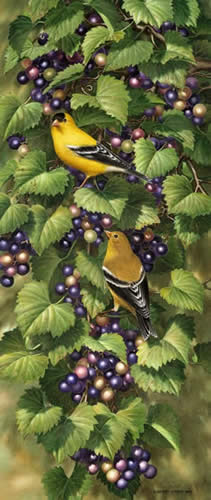
$120
"Vineyard Rendezvous"
Vineyards are cropping up in the Yadkin River valley of North Carolina where tobacco used to grow. Old tobacco curing sheds are giving way to wineries and, in places, the landscape reminds one of scenes along the Rhine or the Moselle River Valleys in Europe. Farmers hanging around the feed store nowadays are as apt to be discussing the current vintage as they are blue mold on tobacco.
In his painting, "Vineyard Rendezvous," Dempsey Essick has filled the frame with ripening muscadine grapes hanging from the parent branch. Contrasted against the distinctive muscadine leaves, a pair of goldfinches sporting their new summer plumage of bright yellow and black seem to be scouting for a nice location to build a nest. The male goldfinch, typically, sports the brighter colors so that he may fulfill his function of guardian. Being more visible, the male can cry and fly across the path of intruders and distract them from the nesting female who has retained much of her duller olive coloration so that she is harder to see when she is sitting on the nest.
They couldn't have found a friendlier neighborhood than the Essick backyard. Dempsey, the bird lover and past President of the NC Bluebird Society, loves not only bluebirds, he loves all birds. His back yard is an avian oasis where he feeds mealworms to the bluebirds, sunflower seed to the cardinals and wrens, Algerian thistle seed to the goldfinches, peanuts to the woodpeckers, and bread crumbs and crackers to the ground feeders.
"Vineyard Rendezvous" reflects the skill and devotion to his craft that we have come to expect of Dempsey Essick. In this painting each small bunch of grapes is perfect. Each leaf is painstakingly depicted. Each shadow and spot of light are exact. The painting could be cut in half, and each half could stand alone as a creditable painting.
Yellow is the color of springtime. After the snow and ice and the drab leafless trees of winter the first yellow blooms of the forsythia give us the promise of springtime. Daffodils pop out of the ground and there are yellow flowers in almost every yard. But it is when we notice that the goldfinches have changed from winter drab to bright yellow and black that we know it is time to get out the short sleeves and sharpen the blades on the lawn mower. And if you don't happen to have one of the tube thistle seed feeders that draw goldfinches like a magnet you can still enjoy Dempsey's painting which is like having a bit of springtime right in your room all year round.
Those who admire Essick's work will not be disappointed with "Vineyard Rendezvous." On close inspection the viewer will see that his powers of observation and natural sense of proportion seem to improve with time. Indeed, while his work ethic drives him to work long hours on each painting, it is his eye for beauty and composition and his love for his subjects that come through in each of his pictures.
As is the artist's custom, he has included a hidden hummingbird image in the painting.
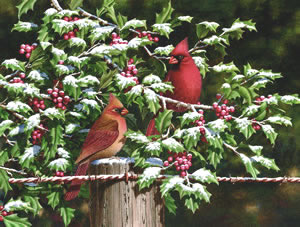
Sold out, unavailable
"Hangin' Out in the Holly"
Cardinals are the most devoted of songbirds. They mate for life. The male and female pair are always within sight of each other. While one is feeding the other always stands watch for predators. They both build the nest. While the female is hatching the eggs the male brings her food and guards the nest. Both bring food to the hatchlings. Cardinals do not migrate which is why you can see them, as Dempsey Essick has portrayed them, perched on a snowy holly branch in winter with their feathers fluffed up for warmth.
Plentiful from Canada all the way to Central America, Cardinals can be found hanging out in gardens, yards and thickets all year. A favorite with Dempsey Essick, he lures the beautiful red birds to his yard with feeders full of sunflower seeds.
"While doing this painting," Dempsey said, "I counted nine cardinals in the dogwood tree outside my studio window. I was always been attracted to the flashy red male, but then I began to notice how beautiful the female's buff reddish brown coloring is and now I pay just as much attention to the female. I loved the whole experience of creating this painting."
Against the dark green of a holly bush shedding the final snow of winter, the two birds in the picture form the perfect image of a mated pair, at ease with each other and sure of the future. It is easy to imagine that the old fence post and wire are habitual resting spots and that there is a plan to build a nest behind the protective stickers of the holly leaves.
Dempsey has done a masterful job depicting the rusty wire and weathered post in contrast with the shiny leaves of the holly bush which still shows the remnants of the last snow. Look closely at the foliage and you will discern the hidden image of a hummingbird worked into the overall design.

$95
"King of the Field"
Standing like a sentinel atop a weathered fence post, an Eastern Bluebird poses against a cloud-bedecked sky and surveys its domain. Notoriously shy, the bluebird seldom ventures into neighborhoods where bird feeders offer up grains and seeds. It prefers living in easy reach of open spaces and quiet groves.
Dempsey Essick, a Past-President of the North Carolina Bluebird Society, has been a constant force, along with other bird fanciers, to educate the public on the plight of the challenged Eastern Bluebird.
"King of the Field" faithfully depicts a typical scene of a bluebird perched on a very realistically painted barbed wire fence post with a cloud-bedecked sky in the background. The clouds in this painting represent a breakthrough for Dempsey, or, indeed, any artist working in transparent watercolors. In watercolors anything white, from clouds to snow to daisy petals, is portrayed simply by leaving the white of the paper unpainted. The problem with clouds is that they aren't flat white but billow and twist and are rounded by shadows. This presents a real problem for the painter, one that Dempsey has been working on for years. Now he has developed the technique for painting clouds realistically and never again will he have to keep his view aimed down, away from the sky.
"King of the Field" was reproduced as giclee, using a new printing process which is more versatile and renders a print very close to the original painting.
Dempsey's Thoughts
This painting holds special meaning to me because it allowed me the opportunity to experiment with painting clouds in watercolor. I worked long hours to develop a technique that would produce the softness of the clouds. The technique involved wetting the paper, applying the paint, and allowing the paint to run naturally. I wetted and rewetted the sky forty some times to get this effect.
I wanted to give the impression in ‘King of the Field' that you are on a blanket looking up at the Eastern Bluebird in his awesome domain and I think I achieved that.
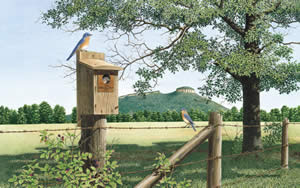
Sold out, unavailable
"Fledgling"
In “The Fledgling”, Bird lover, Dempsey Essick, has captured one of life’s defining moments. Against the backdrop of Pilot Mountain. Mother and father Eastern Bluebirds patiently coax the last of a brood of four to take a leap of faith and fly to a nearby tree where her newly fledged sister and tow brothers are waiting. The youngster is being asked to leave the only world she has ever known, the nest inside the protective box where she hatched and where she has been protected and fed. The experienced parents understand what the child is facing and are patient, knowing that there can be only one conclusion.
When “The Fledgling” finally leaps into space she will discover a freedom known only to a bird. She will exult in zooming to the highest branches, soaring over the landscape, even to the very outside a nesting box, coaxing her own fledglings into that first step into thin air.
The setting for “The Fledgling” is located in Surry County, North Carolina, in the small community of Perch. The view is the south side of Pilot Mountain from the Jack Fulk Farm. The farm is located at the intersection of Grassy Creed Road and Perch Road. “When I was small and I saw that view of the mountain, I knew that I was close to home. It now reminds me of the family members that have gone on and it comforts me with memories we shared,” said Ann Blackburn, daughter of the late Mr. Fulk. Ann’s comments were one reason that Dempsey was drawn to this site.
While “The Fledgling” is a straightforward landscape painting is was, technically speaking, one of the most labor intensive painting Dempsey has done. To attain the “Essick Look” each leaf and blade of grass had to be delineated, shaded and highlighted. There are no shortcuts in this style of painting. Only hundreds of hours of intense effort can bring about a painting like “The Fledgling”. The reward, in the end, is when the artist steps back after the final brush stroke and, through strained and burning eyes looks at what he has accomplished and knows that it is good, that what he has done is worthy of his reputation.
The bluebird box in “The Fledgling” is one designed by Dempsey and, unlike most bluebird boxes, features a rounded top to divert rainwater from the entrance hole. Dempsey feeds birds at home and has also put up a bluebird box behind the Gallery in Welcome. He was delighted when a pair of bluebirds took up residence less than ten minutes after he had finished with the box.
In 2002, the North Carolina Bluebird Society elected Dempsey as president because of his enthusiasm and love of the bluebirds. His desire is to educate the public on the conservational needs of this challenged species. Visitors to the Essick Gallery in Welcome can pick up brochures on the Eastern Bluebird as well as plans for building a nesting box.
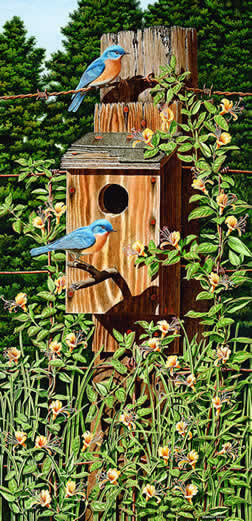
Sold out, unavailable
"Summer Blues"
Eleven years ago, Dempsey Essick's son, John, built a bird house and nailed it up on a nearby fence post. That spring, he was delighted when a pair of bluebirds moved in to raise a family. Each spring after that, the bluebirds would come back and today there are several generations of songbirds who started as hatchlings in John's bird house.
John has gone off to college now and recently the bird house came down along with the fence but Dempsey has always held the scene close in his memory. Helped by a few old snapshots, Dempsey has recreated the scene as it appeared in its last year when the nails had rusted, the wood had weathered and a piece of the shingle had blown off the roof.
In the painting, which he calls "Summer Blues," Dempsey has captured a fleeting moment when both bluebird parents have paused outside the nesting box. The picture reflects Essick's imitable style combining, as it does, the weathered elements of a rusty barbed wire fence emerging from a concentrated tangle of honeysuckle.
Considering that each individual stem, leaf and blossom (there are thirtyseven blossoms) required numerous strokes of his very small brush, it would be safe to say that "Summer Blues" was not only one of Essick's more mature efforts but that the painting also represents an investment of time over and above anything else that the artist has done. His depiction of the weathered wood along with the rust encrusted wire and nail heads combined with the enormous amount of fine detail in the living foliage, required eight weeks of twelve to twenty hour days to complete.
Most viewers will immediately discover the two bees in the painting even as they remember the sweet smell of honeysuckle blossoms. Some will even be reminded of those childhood days when they would pluck the blossoms and suck the sweet nectar from the stems.
Especially sharp eyed viewers will detect a rebus-like hidden image formed by elements of the painting. This is the first painting that Dempsey included a hidden hummingbird.
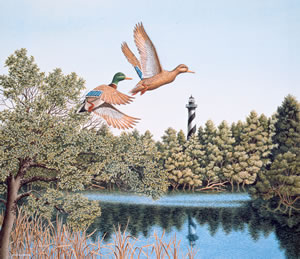
Sold out, unavailable
"My Favorite View of Hatteras"
At about the mid-point of the three hundred mile stretch of barrier islands that defines the eastern edge of the continent along the coast of North Carolina stands the Cape Hatteras Lighthouse. It is the tallest of the six active lights spaced between Currituck in the north and Bald Head Island in the south.
Each of the lighthouses except for Currituck, which is unpainted brick, is painted in a different design, or daymark, for daytime recognition. The most familiar of the six is the bold black and white spiral pattern of the Hatteras light.
The lighthouses at Hatteras, Bodie Island, and Currituck Beach were erected in that order between 1870 and 1875. As the workers finished one, they moved to the next site. All three towers are majestic brick structures of the same basic design. The Hatteras tower, 193 feet tall, is 30 feet higher than the others.
Erected too close to the beach, Hatteras has been threatened by erosion from the beginning. Sometimes, during great storms, when the water reaches almost to the old tower's foundations, there is a real danger that the best know landmark on the east coast will fall.
Perhaps it is the sense of peril that brings more visitors to Hatteras than to any of the other beacons. The majority of the visitor are drawn to the ocean side of the island for fishing, swimming and to see for themselves the threat posed by the encroaching Atlantic. Those visitors frequently miss the wonderful view from the Pamlico Sound side of the island. It is this vista that Dempsey Essick calls "My Favorite View of Hatteras."
From this first viewing, the effect of the painting on the senses is immediate. The viewer is almost overwhelmed with the richness of detail. The Hatteras Light, visible over the top of the surrounding scrub, is a beacon for a pair of Mallards who have burst into flight after being startled from their nesting site at the edge of a small lake.